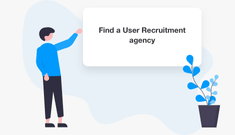How to recruit users for UX testing (plus FREE recruitment template)

Step 1: Identify who your users are
The first thing you need to do before even thinking about how to recruit is to identify who your users are. You need to know this so that you can pull together the criteria for the types of people you need to include in your interviews.
Sources to use:
- Company personas, either from marketing or your UX team
- Analytics data
- Customer survey responses
- Previous quantitative and qualitative research findings
- Stakeholder knowledge (but ensure they can produce evidence rather than this being just their opinion of who your users are!)
What if I’m using the research to find out who my users are?
For many people, research forms part of the process of creating and validating customer personas. In this case, it’s ok not to have fully formed fancy personas, but you’ll still need at least some idea of who your customers might be so that you don’t waste time speaking with entirely wrong people.
Step 2: Document your user criteria
Once you’ve done your fact gathering, you’ll need to pull together your user criteria so that it’s easy for you, your team and your recruiter to understand who you’ll need to take part in your research. Don’t worry about this needing to be an all singing, all dancing pdf document. The main purpose of this document is simply to communicate your user criteria. So, this could just be a very basic one page Word document with bullet points listing out the key demographics and behaviours of your user type(s). For other people, this might be a 10 page visual persona document.
Choose whatever works for you!
Step 3: Find users to take part
So, now that you’ve identified the types of people who you need to include in your research, the next step is to find them. There are a few ways you can do this and we’ll start with the least recommended first.
Using internal employees (least recommended)
Using colleagues and internal employees should be your least used method of recruiting users to take part in your research because it comes with a whole heap of bias! But that’s not to say that it doesn’t have it good points and uses.
Pros
- It’s free!
- It’s quick. In a few hours you can have your feedback.
- It’s useful when you have a very small thing to test and you just want quick feedback on whether people understand design A or design B better.
- It can be a useful tool for driving company awareness of what UX testing is, future engagement and buy-in. But be careful that you then don’t get stuck in a cycle of internal testing because stakeholders then don’t understand why you can’t just stick with internal employees.
Cons
- Bias. This is the big problem with this method. These people work at your company, they’re familiar with the brand, values, they’ve probably used the website/app before, they’re more likely to be similar kinds of people because the company have employed them to fit in with the company culture, etc. Sometimes employees can be more positive in their feedback because they don’t want to say anything negative about their employer or they simply really like the company and that’s why they work there, but sometimes they can be more negative, for example if there is a general negative office culture or if the company has recently announced some bad news. Depending on the company size, they may also be on familiar terms with the researcher and this can influence their responses.
- Employees may be less engaged in the process. We’ve heard of companies forcing employees to take part in research or giving them career incentives, whereas participation in research should be because the person is genuinely interested in taking part and is therefore more highly engaged in the process.
- Even if they are actual customers, they’re not truly representative. Let’s imagine you work at a fashion company like Topshop. Many of your employees may well be customers, and you use this fact to justify using them in your research. However, your preference should still be to recruit people external to the company to eliminate bias.
How to recruit
- Stand up, walk to people’s desks and ask them.
- Put up posters around coffee areas.
- Send out an email.
- Setup a stand in a highly frequented area. You could even do your testing at this stand too and make a day of it.
Recruiting yourself
When you work within a company, someone will undoubtedly have a list of customers/contacts that you could use to access potential participants for your studies.
Pros
- Costs less.
- You can recruit customers from existing contact lists or online popups.
- You have full control over the recruitment and quality of participants.
Cons
- You’ll likely be limited to current customers and lack contact details for non-customers.
- You’re likely to face red tape within your company and will have to check with legal who you can contact, what for and how you’ll need to do this. It’s likely that your approach and email will need to be agreed by several departments which can cause delays and frustration. You may need to compromise on your requirements simply to get sign off.
- Takes up more of your time
- Recruitment can be a very fiddly process. Users may need to call you at inconvenient times or may want to cancel/rearrange their appointment. You’ll need to have availability to deal with them.
- You’ll need someone to be available during your research to deal with last minute dropouts and replacements, help users with directions if they get lost, questions about car parks and buses, and all the other weird and wonderful things that crop up during recruitment.
- Bias. There is a bias if you work for your company. There is a bias if you’re the researcher. When people are recruited by an independent party, they may feel more free to be honest in their opinions.
- There is a bias in only recruiting customers. Customers who say they want to take part in your research may be more likely to be the more engaged positive customers rather than being representative of the average customer.
Recruiting externally
Ideally, you will recruit people who are external to your company. They will be an actual customer or they will represent your target customer as closely as possible so that your research results more accurately reflect your audience with greater reliability and therefore the impact of the results will be greater. Good recruitment is money well spent.
Using a recruitment panel (most recommended)
An external user recruitment agency with their own panel can be used to recruit both your customers and your representative customers. Using an agency takes advantage of their vast network and frees you up to concentrate on your research.
Pros
- Takes the recruitment off your hands and frees you up to concentrate on your research.
- Access an existing panel of users who have already shown an interest in taking part in research.
- Useful for recruiting both general and niche users who are harder to find.
- Gives you easy access to people who aren’t existing customers.
- Gives you easy access to your competitor’s customers for competitor research.
Cons
- Costs more.
- Depending on the company, it can take up to 4 weeks to recruit. But some companies offer much quicker recruitment (iNeedUsers.com).
- You are relying on a third and most likely a fourth party to accurately screen and ensure attendance of your users (Did you know that most agencies don’t recruit directly themselves? They use a network of freelancers around the country so they themselves have no involvement in the quality or consistency of your recruitment). When people aren’t accurately screened, you may receive users who don’t accurately fit your criteria, who are late or unprepared, who aren’t chatty, who struggle to verbalise their thoughts and opinions, and who are more likely to not attend and to not let you know. Experiences like this end up costing you more in wasted time and can be embarrassing for you when you have stakeholders observing.
We recommend: iNeedUsers.com
- 100% user attendance for most projects.
- Free replacement of cancellations and no-shows.
- Rigorous screening process ensures high quality and good fit participants.
- Standard 2 week turnaround with options for faster recruitment.
- Direct recruitment through own panel.
- Qualitative and quantitative.
- Trusted by the world’s top brands.
Download your FREE recruitment template
Together with iNeedUsers, we’ve put together a FREE recruitment template to help you create your requirements when you’re recruiting participants.
You might also like:
Share this post:


